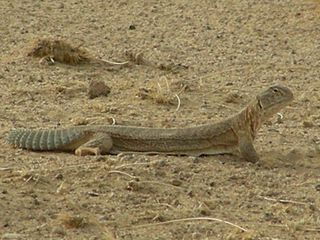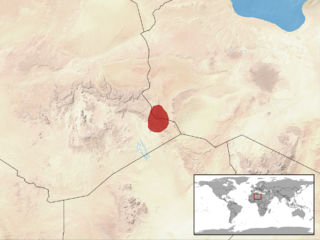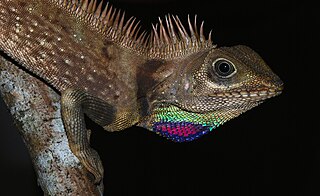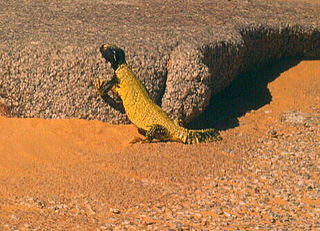
Agamidae is a family of over 550 species of iguanian lizards indigenous to Africa, Asia, Australia, and a few in Southern Europe. Many species are commonly called dragons or dragon lizards.

The Sinai agama is an agamid lizard found in arid areas of southeastern Libya, eastern Egypt, Israel, Jordan, Syria, Saudi Arabia, Oman, eastern Sudan, Ethiopia, Eritrea, and Djibouti.

Uromastyx is a genus of African and Asian lizards in the family Agamidae. Member species are commonly called spiny-tailed lizards, uromastyces, mastigures, or dabb lizards. Lizards in the genus Uromastyx are primarily herbivorous, but occasionally eat insects and other small animals, especially young lizards. They spend most of their waking hours basking in the sun, hiding in underground chambers at daytime or when danger appears. They tend to establish themselves in hilly, rocky areas with good shelter and accessible vegetation.

Urosaurus ornatus, commonly known as the ornate tree lizard, is a species of lizard in the family Phrynosomatidae. The species is native to the southwestern United States and northwestern Mexico. The species, which was formerly called simply the "tree lizard", has been used to study physiological changes during the fight-or-flight response as related to stress and aggressive competition. Its life history and costs of reproduction have been documented in field populations in New Mexico and Arizona. This species has been fairly well studied because of its interesting variation in throat color in males that can correlate with different reproductive strategies,

The granite spiny lizard is a species of lizard in the family Phrynosomatidae.

Calotes emma, commonly known as the forest garden lizard or Emma Gray's forest lizard, is a species of lizard in the family Agamidae. The species is native to China, South Asia, and Southeast Asia. There are two recognized subspecies.

Saara hardwickii, commonly known as Hardwicke's spiny-tailed lizard or the Indian spiny-tailed lizard is a species of lizard in the family Agamidae. The species is found in patches across the Thar desert, Kutch, and surrounding arid zones in India and Pakistan. It is mainly herbivorous and lives in numbers in some areas. Since it is found in loose clusters it often attracts predators such as raptors. It is also hunted by local peoples in the belief that the fat extracted from it is an aphrodisiac.

Cyrtopodion scabrum, also known as the rough-tailed gecko, rough bent-toed gecko, rough-tailed bowfoot gecko, common tuberculate ground gecko, or keeled gecko, is a species of gecko, a lizard in the family Gekkonidae. The species is endemic to Asia.

Eumeces schneiderii, commonly known as Schneider's skink, is a species of lizard in the family Scincidae. The species is endemic to Central Asia, Western Asia, and North Africa. There are five recognized subspecies.

Uromastyx geyri is a species of lizard belonging to the family Agamidae. The species is native to North Africa.

Laudakia stellio is a species of agamid lizard. also known as the starred agama or the roughtail rock agama.

Uromastyx alfredschmidti, commonly known as the ebony mastigure, Schmidt's mastigure, or Schmidt's spiny-tailed lizard, is a species of lizard in the family Agamidae. The species is indigenous to North Africa.

Draco indochinensis, also known as the Indochinese flying lizard or Indochinese gliding lizard, is a species of agamid lizard endemic to South-east Asia.

Uromastyx princeps, commonly known as the princely mastigure, princely spiny-tailed lizard, or Somalian mastigure, is a species of lizard in the family Agamidae.

Uromastyx aegyptia is a species of lizard in the family Agamidae. The species is endemic to North Africa and the Middle East.

Diploderma swinhonis, also known commonly as the Taiwan japalure, Swinhoe's japalure, Swinhoe's lizard, and Swinhoe's tree lizard, is a species of lizard in the family Agamidae. The species is native to Taiwan. It is considered an invasive alien species in Japan after likely being transported from Taiwan by humans. A foraging ambush predator, this lizard preys primarily on arthropods and thus remains at the bottom of forests perched on trees where sunlight is present. D. swinhonis is not a major threat to humans and is able to adapt to a variety of habitats, including urban environments. The male D. swinhonis is physically distinct from the female, with its body size being much larger and having a yellow stripe. This species sexually reproduces on a seasonal basis and hibernates during the winter time.

Gonocephalus bellii, commonly known as Bell's anglehead lizard or Bell's forest dragon, is a species of lizard in the family Agamidae. The species is native to Southeast Asia and Oceania.

Paralaudakia stoliczkana is a species of lizard in the family Agamidae. The species is native to Xinjiang and Gansu provinces in China, the western parts of Mongolia, and to Kyrgyzstan. There are two recognized subspecies.

Uromastyx dispar, the Sudan mastigure, is a species of agamid lizard. It is found in Mauritania, Sudan, Chad, Western Sahara, Algeria, and Mali.





















